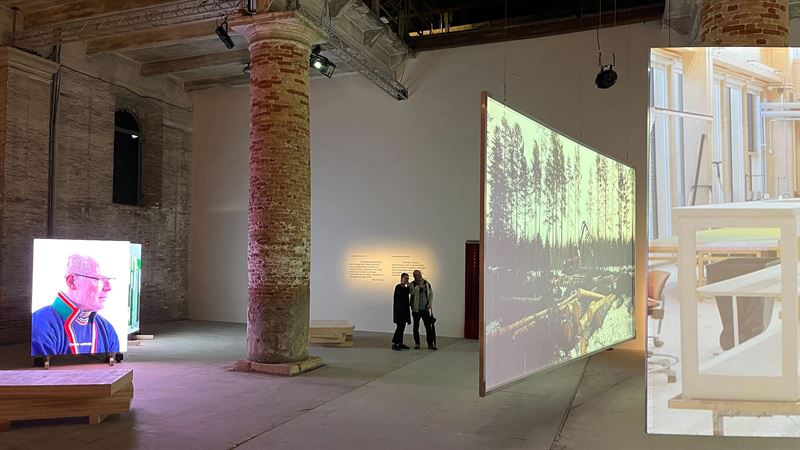
This weekend the 18th International Architecture Exhibition of La Biennale di Venezia opens. Earlier this spring, it was announced that White Arkitekter has been invited by this year’s curator Lesley Lokko to exhibit in the main Exhibition The Laboratory of the Future. White Arkitekter’s contribution to the exhibition raises the question of whether it is possible to find a balance between the forest as a resource and the urgent need to preserve and rebuild fragile ecosystems.
The Laboratory of the Future aims to solve two of the biggest challenges of our time: decarbonisation and decolonisation. White Arkitekter is exhibiting in the Arsenale in the Dangerous Liaisons section which the architectural practice interprets by presenting and analysing the relationship between large-scale timber architecture, forestry, and the forest. The construction industry accounts for a high proportion of carbon dioxide emissions. Wood store carbon dioxide and can therefore help to reduce the climate impact of construction. The forest industry is an important cornerstone of the Swedish economy and plays a key role in the development of a sustainable and bio-based society. At the same time, the question of how large-scale timber construction affects biodiversity, and the cultural significance of the forest is complex.
In the 18th Exhibition, White Arkitekter takes the 20-storey timber building Sara Cultural Centre in Skellefteå as a starting point and examines how a timber project on that scale affects the forest. The project consists of three documentary-like films showing the forest, the forest industry and Sara Cultural Centre and examines the project’s use of materials and the extraction of raw materials from the forest. Through interviews with representatives from the forest industry, the Swedish Society for Nature Conservation and the Sami culture, the exhibition highlights multiple perspectives on the forest and its importance.
– In recent years, timber construction has had a renaissance. The drive to speed up the transition to climate neutrality is positive. At the same time, it is important to understand the consequences of our methods and drive the development of our cities in a sustainable way. How do we find the balance between the forest as a raw material on the one hand and protecting biodiversity and valuable ecosystems on the other hand? We want to highlight different perspectives as this is a complex issue. White Arkitekter’s contribution will be a dialogue about modern timber construction with Sara Cultural Centre as an example. We want to inspire a discussion about how we can go one step further in our way of working with design in timber in balance with nature, says Alexandra Hagen, CEO, White Arkitekter.
When White Arkitekter exhibits in the Arsenale this year, it is as one of the few representatives from northern Europe.
– Our invitation to the Biennale Architettura 2023 is a result of a long-term strategic work where we work with design as a method to achieve sustainability. Several political initiatives such as the New European Bauhaus and the EU taxonomy are increasing the demand for sustainable architecture. This is something we experience by an increased demand for our knowledge from new geographies, says Alexandra Hagen, CEO, White Arkitekter.
The 18th International Architecture Exhibition of La Biennale di Venezia runs from the 20th of May to 26th of November 2023.
For more information:
Louise Lundberg, Head of Public Relations, White Arkitekter
+46 73 722 51 69
louise.lundberg@white.se
Founded by Sidney White in 1951, White Arkitekter is Scandinavia’s leading architectural practice. We work with sustainable architecture, urban design, landscape, and interiors to create lasting value for current and future generations. We are an employee-owned collective of about 700 employees with a presence in Sweden, Norway, UK, Germany, Canada, and East Africa. As architects, we have a responsibility to take action against climate change and by 2030, we aim for all our projects will be climate neutral. To that end, we have strengthened research and design skills that focus on timber technologies. Our Roadmap 2030 sets out White’s direction for how it will contribute to the transition required in society to achieve national and international climate goals, as well as our own. From relocating the Arctic city of Kiruna two miles east, to empowering women at Panzi Hospital, we put people, planet, and local economies at the forefront of design.
Connect with us to learn more: www.whitearkitekter.com or @whitearkitekter on social media.
